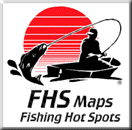 |
|
|
Click on the image to vote for this site. Want to join The Top 1000 Fishing Sites, click here! Want to view the list, click here!
|
Early Ice Tactics
The first few weeks of ice is some of the most incredible action of the whole ice fishing season. The walleye are cruising big time and still have the fall feed bag on. Taking advantage of this time is a matter of interpreting the situation and then game planning your moves for success. The good news is that the walleye will probably be using the same areas that they did before the water froze. This makes it very easy to pinpoint their moves and locations. The first thing we need to do to put together a successful game plan
is to take a map and mark the areas we wish to target. I use two tools
to do this my First ice can really present a myriad of conditions, much like open water. If the ice is milky and light penetration is inhibited then I need to take very few precautions against spooking fish. However if the ice is clear and I can see through it, then we need to compensate. I do this one of two ways. If there is snow on the ground, I drag a sled of it with me out to the holes. I spread the snow around me so that fish cannot see my silhouette up on the ice. In the absence of snow, I’ll use a piece of white carpeting. Don’t use dark carpeting because it will absorb heat and melt the ice underneath it. Both of these tricks make me less intrusive into the fish’s environment and result in more bites from less wary fish. This leads me into the subject of stealth. During first ice, the fish can become spooky. The water is amazingly clear, and light can penetrate very easily through the thinness of the ice. I travel light and carry a minimum of gear. A critical factor in this is drilling my holes. I use a StrikeMaster Lazer hand auger to drill the holes, rather than a gas powered auger or using a spud. If you create too much commotion on the ice, you may spook the fish away for several hours. The StrikeMaster Lazer hand auger is sharp and cuts quick making it the most silent approaches I’ve found. As to the other gear to bring with you make sure you have a good portable
depth finder. I use the Baits and tackle that I bring out also fall into the traveling light
category. Key spoons and swimming lures are For Tackle, my rods are Once we arrive at our spot and have our holes drilled, were ready to
begin fishing. When the law allows I always fish two rods, one jigging,
one dead. A dead rod is nothing more than a rod that sits still with
the bait presented motionless by the angler. Either rigged with a
good Most days when fishing my dead rod accounts for half my catch, and becomes especially effective in the afternoon. In fact there are days when the dead rod can account for over 75% of the strikes I’ll receive. It seems as though with very finicky fish, the action of the jigging rod can get there attention and bring them in for a look see, but is too active for there tastes. With the dead rod right there, the minnow just flailing and enticing them, they can’t resist trying to pick off an easy meal. This brings me to the jigging rod, and how to work it for achieving your total potential. If you’ve ever looked out on the ice, it looks like a dance floor with everyone’s slight variations. Some jig fast, some constant, some slow, some pause. For me a simple lift drop of six to 12 inches is as much action as I usually impart. During this I’ll have many pauses and variations of the pause. Mostly these variations are just wiggling my rod tip slightly to impart a light frantic vibration to the bait. A typical jigging sequence for me is raising and lowering three to four times in about 30 seconds. This type of methodical approach to jigging is the most effective technique I have ever come across. Bring em in with action, and entice em to bite by hanging a bait in there face. Well there you have it, my first ice strategies for the upcoming season. These are things I have learned from many years of experience as a professional fisherman, and I hope they can benefit you. See Ya on the ice
Please visit these site sponsors |
|---|---|

